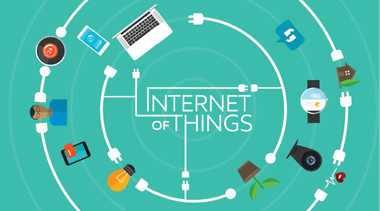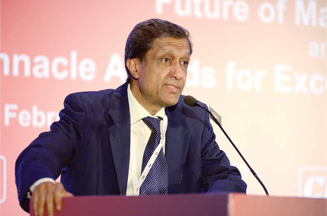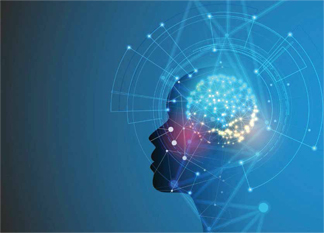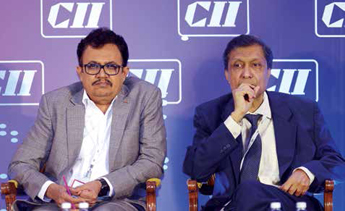Internet of Things (IoT), Digital manufacturing and Automation are the tools we have to shape a new manufacturing future. India must adopt new technologies along with the world to ensure we are shoulder to shoulder with the best in the world

India is on its way to become a one trillion dollar manufacturing economy. With such vast ambition come numerous obstacles. What exactly, then are the challenges and advantages in the next phase of globalization. As we bring you the concluding part of the session on globalization 4.0 – Advantages and Challenges, held at the CII conference on ‘The Future of Manufacturing’, S Sundarram, Managing Director, Lincoln Electric, talks about how the Internet of Things (IoT), Digital manufacturing and automation will change the manufacturing landscape as we know it
S Sundarram: In the past few years, I am sure you have heard a lot of concepts being thrown at you like digital manufacturing. I am going to be talking on simple two things. Why is it essential? And how do we go about implementing it and in which areas?
I come from a company called Lincoln electric. This is a U.S. based company. Lincoln is a three billion dollar company that is essentially into welding, and it is also the world leader in the field. I run the Indian operations. The U.S. operations are 123 years old. Our Indian operations are about eight years old. When we talk about digital manufacturing, our team in the U.S. does everything, as they have tremendous technology, and they initially said they will pass on the technology to us and we will implement it. Now after two years of our digital journey, the situation is such that we have a team from U.S. who are coming down to our factory in April, to actually see what we have implemented and how we have implemented it and to go back and replicate it in the U.S. So these are our advantages compared to the U.S. I want to talk about how an industrial revolution happens; there are certain changes that happen which are inevitable and there is no going back and there are people who do not change.
Let’s take the example of the journey of cotton. There is a manual way of handling it. Now we say a 25 per cent increase in productivity is good, but 25 times is 2500 per cent. So obviously who is operating at X cannot compete with someone who is competing at 2500 X. What are the inevitable things that have happened? Two things have happened, we have moved from an agrarian society to an urban society and seen the formation of urban centers etc. Those are also inevitable, but those are socio-economic changes which I am not going to talk about, I am going to talk about the industry. If we talk about mechanization, we all know, can industry operate without mechanization? Can a person work it all with hands? Obviously not. But the other thing that came about is standardization, the concept of interchangeable parts which was the forerunner to mass production. Interchangeable parts are one thing that they had to make for mass production, one thing that the people in the west are very keen on in mass pro during are guns. Guns had to come with interchangeable parts and that was how the concept of standardization came. With the concept of standardization, if you ask about the second industrial revolution, and that is the defining image is the novelty of the Ford’s assembly line.
The things which came about as a change are electrification and mass production. Yes, mass production may undergo some change, like mass production to mass customization, but at that point of time and even today it is considered an essential part of an industry. I am mentioning this in context of what are the changes that come about in industrial revolution, either you change or you perish. We got to the third industrial revolution and contrary to popular belief, defining image of the robot is not part of the fourth industrial revolution, which is automation and computerization. The fourth industrial revolution is not so much about automation but autorotation, which is not about moving human lab our but about moving human intervention. So then we come to the fourth industrial revolution, we all know what this is all about, there are so many other things which I am not going to talk about like nanotechnology and new materials and so on and so forth. So I am just focusing on these four items that tend to go together and they are all part of the fourth industrial revolution. Somebody might say block chain technology and quantum computers are also there, but when I look into manufacturing these are the central elements of 4.0.
If you look at the power of the internet, the Internet of Things (IoT) relates to very old concepts. It is about getting information and using it. We have collected a huge mass of data and what do we do with it? That is not the implementation of IoT. Implementation of IoT is a collection of data and using it in a manner that delivers benefits

The inevitable changes that we saw from the first industrial revolution that are standardization and mechanization. What are the changes that are going to take place that are going to leave companies behind if they do not follow? Those are digital transformation and Digitalization. When we talk about it let me explain it from my context and the way I look at it. Digitizationis slightly different from Digitalization. Digitizationis converting from analogue to digital. Digitalization and digital transformation are generally used interchangeably, but I say Digitizationis collecting data and Digitalization using that collected data in manners that are already available to us today. Look at other trends, look at autonomisation, which is artificial intelligence, coming in to make machines autonomous, so we are talking about autonomous cars and we talk about other machines which operate without human intervention. The fundamental difference between a smart machine and an automated machine of the past is that the automated machine or the robot of the past is programmed to do a particular job whereas, the autonomous machine of the future is programmed to learn.
The third thing which I heard in the earlier talks is about virtualization, virtual reality and augmented reality are things which are coming. But I think about Digitizationwhich I think is almost inevitable. It is because, see, if you look at the power of the internet, the Internet of Things (IoT) relates to very old concepts. It is about getting information and using it. We have collected a huge mass of data and do what with it? That is not the implementation of IoT. Implementation of IoT is a collection of data and using it in a manner that delivers benefits. So why I say the IoT, in all factories is a certainty and is also imminent because this is the first trend that I see. Users are talking about benefits, and benefits that we have personally realized, this is something we can all talk about, I cannot talk about others but this is something we have seen. Workers all have smart phones. You give them all these control charts and they have to fill it. When they see this digital image in their smart phones they click it and they find it a lot easier. Customers are demanding it, workers find it easier to work with, machine suppliers are offering it, especially in plastic injection and moulding. Then there is one of our customers who uses huge lines for the manufacture of chips, PepsiCo uses a huge variety of flavour in chips, they use artificial intelligence to monitor the flavours, they monitor that the right flavour is going into the right batch of chips. This is the kind of change coming about and the benefits that are being seen are astounding. As more and more parts are being outsourced, what is the technology and what is the trend and how is it being used?
The fundamental difference between a smart machine and an automated machine of the past is that the automated machine or the robot of the past is programmed to do a particular job whereas, the autonomous machine of the future is programmed to learn

As an increasing proportion of parts are being outsourced, there is an increase in need to control the quality and output and this I will share with you an actual experience of an (Original Equipment Manufacturer) OEM in Chennai. They have all critical parts, these are single sourced parts in IoT and they have vendors all over India. Here is the scary part. Any part that goes out of state is going directly to the OEM. You might think this is the digital world of the big brother watching you, but that is the kind of trend that is coming these days. People who are suppliers of these OEMs can understand that this is a trend and one experience I shall share is two years ago somebody came to us to buy our machine, which is slightly more expensive than our competitors. We asked him why? You are not using any other facility this machine has. He said we are using this IoT facility. We asked, why IoT? All you do is collect the data. Our customer, who happens to be a car manufacturer in Chennai said that you have to have this because in case of any failure or issue we want to go to the actual weld data. This is a trend that has come. They are monitoring so many vendors, they outsource around 2000 parts and as they are monitoring vendors. Say a vendor has not been given a part as per schedule, they are being given 100 parts and say after four days he has only produced 30 parts, an alert goes to the OEM and they are able to follow up, they fix things so that their production is not affected. The OEMs have control over output and quality and also over cost. This is a very strong control. You may say it is not good news for vendors, but it actually a very good news because if you are a vendor and you have the facility of IoT in your plant, you can show this to the OEM and tell them this is the level of transparency we have to offer you and that becomes a good selling point and that is a competitive advantage. And the way they work, their system is tied up and they determine the total number of parts produced and the total number of parts rejected and they make a count and let’s say they have produced 100 parts and four are rejected, the system will only inward 96 parts. This is not the future, somebody is already doing it for their critical parts and they want to extend it to all others. So we offer machines with IoT and typically this is how IoT will look like and it will give you a range of information - usable and actionable information. For example, let’s say we have welders who are performing less and whose process capability is less, actionable information is obtained and immediate action and counseling is done. So my advice is if you are buying machines, demand Internet of Things, and if you are selling machines install it. Many companies fail to implement IoT. I will talk about the dark factory; one of our 45 factories in the Netherlands, we have to treat this project as IoT and artificial intelligence and make it a dark factory. The total bill they presented to management for capes was 4.5 million euro, management said it is nice and we like the concept, but where is the money and the return on investment? So top management sometimes ask these very damaging questions, and that is how I have found that a number of highly enthusiastic IoT implementations have been stalled. You have to present to management the data on how actually you will save money. Here is the answer, you start small, get quick wins and then you scale up. My humble advice is, keep the IT department out of IoT implementation, we have done that and it has worked for us. This is a hurdle we have found in other companies that the conflicting objectives between the IT and operations lead to disaster. We started small, were owned by operations and we realized the benefits and we started scaling up. We were already doing these things earlier, but we did not have that depth of data to do it better. For example, the control chart. The supervisor and line inspector have a line between them, the moment it goes askew, there is a ping…the moment there is a ping he has to rush. If the ping remains for a long time, the ping goes to his boss and then there is an escalation matrix. All the action has to be entered in logbooks, and I can see whatever the errors that have happened the last week and I can see whatever the actions that have been taken. We can review those things for the future.
Digital transformation is the use of digital technologies. Virtual reality has become a common buzzword and the reason I have mentioned is because it acts as a virtual trainer. It gives us essential cues
 (L to R) Parakram Singh Jadeja with S Sundarram
(L to R) Parakram Singh Jadeja with S SundarramSo what we have done is we have monitored different kinds of machines which have produced and therefore they should be using similar levels of energy and here is what we found. I will give an example. There are two machines, similar products but highly different levels of energy consumption. Deeper analysis shows that the air pressure settings inside those machines for idlers are different, there is a standard but they are not being followed very precisely and that difference was there. We checked across several identical machines and found a difference, and we checked them and corrected them. Implemented savings was seven lakhs a year, but the kits we put in to get IoT information cost approximately five lakhs or so. Then we can say we can scale up and go for big scale implementation. There is a machine which ramps up from 0 to its full speed, there is certain timing we give to ramp up to full speed, but different ramp operators have different timing. Some people want to play it very safe, then we get information about the time of ramp up speed and full speed and then we identify who these operators are then they say we will do it like this. Once that is done it is a saving of four per cent and this along with other saving we found and OEE of nearly eight per cent. People asked us to raise capes because we had reached our capacity now. Now we do not need to raise capes and we have saved the cost of one machine by putting in and using IoT. People from US are coming over to see what these people are doing. This is the kind of thing that is very easy to implement. With thermal imaging and temperature monitoring, we get information about the parts of the machine which are not functioning as per norm. Digitalization is what I say is the thing which is the present and will give a competitive advantage to whoever does it, it is strengthening of what you are already doing. This provides information to be able to enhance that action. If you are an OEM or a vendor to an OEM, either way, the implementation will give you a benefit.
Digital transformation is the use of digital technologies. Virtual reality has become a common buzzword and the reason I have mentioned is because it acts as a virtual trainer. It gives us cues like your distance is too far or you are holding the torch in a wrong way. So we can do welding without having to spend money on the parts and all that smoke, fume and safety and we do not need a trainer. Virtual reality in design is being used and is likely to be a trend. These are all reductions in cost, and we have a virtual reality safety training done for our welding. It cost us 1.8 lakhs and not 1.8 crores. Virtual reality is slightly different from augmented reality, which is coming really quickly. Virtual reality means everything is unreal, augmented reality means you are actually seeing the part. So it reduces errors and increases efficiency and is basically for manufacturing. Virtual reality is more for training and augmented reality is more for manufacturing. Cost for augmented reality is very high and hopefully, it will come down soon, with all these digital technologies, India has a very good scope in the future. Identical products here would have cost more than 10 times in the U.S, so it is a huge advantage in India. Digital transformation in welding is an important part, all the changes which were there earlier hardware driven and now is software driven. The software is waveform technology and it manipulates the current in a way which makes it able to do welding with the least of non-productive time and reduces the leak output which is a critical factor so that you can get an 80 per cent improvement in productivity and a higher level of accuracy. This is a trend and use of technology is a development.
Top management sometimes ask very damaging questions, and that is how I have found that a number of highly enthusiastic IoT implementations have been stalled. You have to present to management the data on how actually you will save money. Here is the answer, you start small, get quick wins and then you scale up
People may have seen Gary Kasparov, Chess champion being beaten by a machine. When will a robot team win the world cup? There is an opinion of artificial intelligence that after the wheel, the Artificial Intelligence is the second most important invention for mankind, and the second opinion is that it the second threat for humanity after the nuclear bomb. For a robot team to win the world cup they have given time till 2050, but some say it won’t even happen until 2150 because robots have poor hand-eye coordination in an uncontrolled environment. These are varied and contradicting views; for those of you seeing YouTube may have seen an IKEA challenge wherein a human assembling furniture versus a robot assembling furniture and how the robot struggles with very simple tasks. There is a fair amount of artificial intelligence that is analytical, instead of humans, the analysis will be done by Artificial Intelligence and that gives you a lot more powerful data.
Finally, additive manufacturing is very good when you tend to have very large materials, compared to subtractive manufacturing wherein the cost is high, like a jet engine nozzle which is a cobalt-titanium alloy, subtractive manufacturing gives heavy savings. There is another part is an excavator with a huge gigantic part with complex internal pathways, it is traditional subtractive manufacturing, difficult and complex to do with and this is done by arc welding. The third is custom made parts and is likely not to be coming in trend for mass production.
By Neeraj Varty